Sub-Shrub Components Change the Soil Water Storage Response to Daily Precipitation and Air Temperature in the Loess Plateau
Abstract
:1. Introduction
2. Materials and Methods
2.1. Study Area
2.2. Field Experiments
2.3. Data Analysis
2.4. Statistical Analysis
3. Results
3.1. The Mean Daily W and the Distribution of ∆W for Different Treatments
3.2. Responses of ∆W to P and Ta for Each Day
3.3. Different Responses on Rainy Days or No-Rain Days
3.4. Effects of Different Treatments on ∆W Changes
3.5. Effects of Different Treatments on Soil Water Infiltration, Loss and Retention
4. Discussion
4.1. Effect of P and Ta on Soil Water on a Daily Scale
4.2. Response of Soil Water Storage Processes to Sub-Shrub Components
5. Conclusions
Author Contributions
Funding
Data Availability Statement
Conflicts of Interest
References
- Yu, Y.; Hua, T.; Chen, L.; Zhang, Z.; Pereira, P. Divergent Changes in Vegetation Greenness, Productivity, and Rainfall Use Efficiency Are Characteristic of Ecological Restoration Towards High-Quality Development in the Yellow River Basin, China. Engineering 2023. [Google Scholar] [CrossRef]
- Wang, S.; Fu, B.J.; Chen, H.B.; Liu, Y. Regional development boundary of China’s Loess Plateau: Water limit and land shortage. Land Use Policy 2018, 74, 130–136. [Google Scholar] [CrossRef]
- Wang, Y.Q.; Shao, M.A.; Zhu, Y.J.; Liu, Z.P. Impacts of land use and plant characteristics on dried soil layers in different climatic regions on the Loess Plateau of China. Agric. For. Meteorol. 2011, 151, 437–448. [Google Scholar] [CrossRef]
- Sun, W.Y.; Mu, X.M.; Song, X.Y.; Wu, D.; Cheng, A.F.; Qiu, B. Changes in extreme temperature and precipitation events in the Loess Plateau (China) during 1960–2013 under global warming. Atmos. Res. 2016, 168, 33–48. [Google Scholar] [CrossRef]
- Fu, B.J.; Wang, S.; Liu, Y.; Liu, J.B.; Liang, W.; Miao, C.Y. Hydrogeomorphic Ecosystem Responses to Natural and Anthropogenic Changes in the Loess Plateau of China. Annu. Rev. Earth Planet. Sci. 2017, 45, 223–243. [Google Scholar] [CrossRef]
- Yu, Y.; Zhao, W.W.; Martinez-Murillo, J.F.; Pereira, P. Loess Plateau: From degradation to restoration. Sci. Total Environ. 2020, 738, 140206. [Google Scholar] [CrossRef]
- Tsang, L.; Liao, T.H.; Gao, R.X.; Xu, H.K.; Gu, W.H.; Zhu, J.Y. Theory of Microwave Remote Sensing of Vegetation Effects, SoOp and Rough Soil Surface Backscattering. Remote Sens. 2022, 14, 3640. [Google Scholar] [CrossRef]
- Etminan, A.; Tabatabaeenejad, A.; Moghaddam, M. Retrieving Root-Zone Soil Moisture Profile From P-Band Radar via Hybrid Global and Local Optimization. IEEE Trans. Geosci. Remote Sens. 2020, 58, 5400–5408. [Google Scholar] [CrossRef]
- Zribi, M.; Sahnoun, M.; Dusséaux, R.; Afifi, S.; Baghdadi, N.; Ben Hamida, A. Analysis of P band radar signal potential to retrieve soil moisture profile. In Proceedings of the 2016 2nd International Conference on Advanced Technologies for Signal and Image Processing (ATSIP), Monastir, Tunisia, 21–23 March 2016. [Google Scholar]
- Neusch, T.; Sties, M. Application of the Dubois-model using experimental synthetic aperture radar data for the determination of soil moisture and surface roughness. Isprs J. Photogramm. Remote Sens. 1999, 54, 273–278. [Google Scholar] [CrossRef]
- Dave, R.; Kumar, G.; Pandey, D.K.; Khan, A.; Bhattacharya, B. Evaluation of modified Dubois model for estimating surface soil moisture using dual polarization RISAT-1 C-band SAR data. Geocarto Int. 2021, 36, 1459–1469. [Google Scholar] [CrossRef]
- Gharechelou, S.; Tateishi, R.; Sumantyo, J.T.S.; Johnson, B.A. Soil Moisture Retrieval Using Polarimetric SAR Data and Experimental Observations in an Arid Environment. Isprs. Int. J. Geo.-Inf. 2021, 10, 711. [Google Scholar] [CrossRef]
- Yu, Y.; Zhu, R.P.; Ma, D.M.; Liu, D.J.; Liu, Y.; Gao, Z.Q.; Yin, M.Q.; Bandala, E.R.; Rodrigo-Comino, J. Multiple surface runoff and soil loss responses by sandstone morphologies to land-use and precipitation regimes changes in the Loess Plateau, China. Catena 2022, 217, 106477. [Google Scholar] [CrossRef]
- Li, L.J.; Song, X.Y.; Zhao, X.K.; Meng, P.F.; Feng, D.; Fu, C.; Wang, L.; Jiao, R.Y.; Wei, W.Y.; Li, H.Y. Modeling the impact of climate change and vegetation conversion on water budget: A case study in the Loess Plateau of China. J. Hydrol. Reg. Stud. 2022, 40, 101040. [Google Scholar] [CrossRef]
- Longobardi, A.; Khaertdinova, E. Relating soil moisture and air temperature to evapotranspiration fluxes during inter-storm periods at a Mediterranean experimental site. J. Arid Land 2015, 7, 27–36. [Google Scholar] [CrossRef]
- Huang, L.M.; Shao, M.A. Advances and perspectives on soil water research in China’s Loess Plateau. Earth Sci. Rev. 2019, 199, 102962. [Google Scholar] [CrossRef]
- Ge, F.C.; Xu, M.X.; Gong, C.; Zhang, Z.Y.; Tan, Q.Y.; Pan, X.H. Land cover changes the soil moisture response to rainfall on the Loess Plateau. Hydrol. Process 2022, 36, 14714. [Google Scholar] [CrossRef]
- Jin, Z.; Guo, L.; Lin, H.; Wang, Y.Q.; Yu, Y.L.; Chu, G.C.; Zhang, J. Soil moisture response to rainfall on the Chinese Loess Plateau after a long-term vegetation rehabilitation. Hydrol. Process 2018, 32, 1738–1754. [Google Scholar] [CrossRef]
- Dai, H.; Wang, H. Influence of rainfall events on soil moisture in a typical steppe of Xilingol. Phys. Chem. Earth 2021, 121, 102964. [Google Scholar] [CrossRef]
- Chen, L.; Zhang, K.L.; Zhang, Z.D.; Cao, Z.H.; Ke, Q.H. Response of soil water movement to rainfall under different land uses in karst regions. Environ. Earth Sci. 2023, 82, 50. [Google Scholar] [CrossRef]
- Wang, S.; Fu, B.; Gao, G.; Liu, Y.; Zhou, J. Responses of soil moisture in different land cover types to rainfall events in a re-vegetation catchment area of the Loess Plateau, China. Catena 2013, 101, 122–128. [Google Scholar] [CrossRef]
- Du, H.; Jiao, F.; Yao, J.; Li, D.; Fang, Z. Effects of Precipitation Changes on Soil Moisture Characteristics of Returning Farmland in Loess Hilly Region. Res. Soil Water Conserv. 2019, 26, 81–88. (In Chinese) [Google Scholar]
- Ramos, M.C.; Jones, G.V.; Martinez-Casasnovas, J.A. Structure and trends in climate parameters affecting winegrape production in northeast Spain. Clim. Res. 2008, 38, 1–15. [Google Scholar] [CrossRef]
- Liu, X.M.; Zhang, D. Trend analysis of reference evapotranspiration in Northwest China: The roles of changing wind speed and surface air temperature. Hydrol. Process 2013, 27, 3941–3948. [Google Scholar] [CrossRef]
- Materia, S.; Ardilouze, C.; Prodhomme, C.; Donat, M.G.; Benassi, M.; Doblas-Reyes, F.J.; Peano, D.; Caron, L.P.; Ruggieri, P.; Gualdi, S. Summer temperature response to extreme soil water conditions in the Mediterranean transitional climate regime. Clim. Dyn. 2022, 58, 1943–1963. [Google Scholar] [CrossRef]
- Niu, X.T.; Fan, J.; Du, M.G.; Dai, Z.J.; Luo, R.H.; Yuan, H.Y.; Zhang, S.G. Changes of Rainfall Partitioning and Canopy Interception Modeling after Progressive Thinning in Two Shrub Plantations on the Chinese Loess Plateau. J. Hydrol. 2023, 619, 129299. [Google Scholar] [CrossRef]
- Lunka, P.; Patil, S.D. Impact of tree planting configuration and grazing restriction on canopy interception and soil hydrological properties: Implications for flood mitigation in silvopastoral systems. Hydrol. Process 2016, 30, 945–958. [Google Scholar] [CrossRef]
- Wang, D.; Wang, L.; Zhang, R. Measurement and modeling of canopy interception losses by two differently aged apple orchards in a subhumid region of the Yellow River Basin. Agric. Water Manag. 2022, 269, 107667. [Google Scholar] [CrossRef]
- Cui, Y.S.; Pan, C.Z.; Zhang, G.; Sun, Z.W.; Wang, F.X. Effects of litter mass on throughfall partitioning in a Pinus tabulaeformis plantation on the Loess Plateau, China. Agric. For. Meteorol. 2022, 318, 108908. [Google Scholar] [CrossRef]
- Cui, Z.; Huang, Z.; Luo, J.; Qiu, K.Y.; Lopez-Vicente, M.; Wu, G.L. Litter cover breaks soil water repellency of biocrusts, enhancing initial soil water infiltration and content in a semi-arid sandy land. Agric. Water Manag. 2021, 255, 107009. [Google Scholar] [CrossRef]
- Villegas, J.C.; Breshears, D.D.; Zou, C.B.; Law, D.J. Ecohydrological controls of soil evaporation in deciduous drylands: How the hierarchical effects of litter, patch and vegetation mosaic cover interact with phenology and season. J. Arid. Env. 2010, 74, 595–602. [Google Scholar] [CrossRef]
- Zhao, L.S.; Meng, P.; Zhang, J.S.; Zhang, J.X.; Sun, S.J.; He, C.X. Effect of slopes on rainfall interception by leaf litter under simulated rainfall conditions. Hydrol. Process 2022, 36, e14659. [Google Scholar] [CrossRef]
- Cui, Z.; Wu, G.L.; Huang, Z.; Liu, Y. Fine roots determine soil infiltration potential than soil water content in semi-arid grassland soils. J. Hydrol. 2019, 578, 124023. [Google Scholar] [CrossRef]
- Wang, H.F.; Zhu, X.A.; Zakari, S.; Chen, C.F.; Liu, W.J.; Jiang, X.J. Assessing the Effects of Plant Roots on Soil Water Infiltration Using Dyes and Hydrus-1D. Forests 2022, 13, 1095. [Google Scholar] [CrossRef]
- Wu, G.L.; Liu, Y.; Yang, Z.; Cui, Z.; Deng, L.; Chang, X.F.; Shi, Z.H. Root channels to indicate the increase in soil matrix water infiltration capacity of arid reclaimed mine soils. J. Hydrol. 2017, 546, 133–139. [Google Scholar] [CrossRef]
- Song, T.J.; An, Y.; Wen, B.L.; Tong, S.Z.; Jiang, L. Very fine roots contribute to improved soil water storage capacity in semi-arid wetlands in Northeast China. Catena 2022, 211, 105966. [Google Scholar] [CrossRef]
- Liu, J.B.; Liang, Y.; Gao, G.Y.; Dunkerley, D.; Fu, B.J. Quantifying the effects of rainfall intensity fluctuation on runoff and soil loss: From indicators to models. J. Hydrol. 2022, 607, 127494. [Google Scholar] [CrossRef]
- Liu, J.B.; Gao, G.Y.; Chen, W.L.; Fang, W.W.; Su, C.H.; Zhang, B. Effect of grass components on the temporal response of surface soil water to precipitation and air temperature in the Loess Plateau. Air Soil Water Res. 2023, 16. [Google Scholar] [CrossRef]
- Liu, J.B.; Gao, G.Y.; Wang, S.; Jiao, L.; Wu, X.; Fu, B.J. The effects of vegetation on runoff and soil loss: Multidimensional structure analysis and scale characteristics. J. Geogr. Sci. 2018, 28, 59–78. [Google Scholar] [CrossRef]
- He, Z.M.; Jia, G.D.; Liu, Z.Q.; Zhang, Z.Y.; Yu, X.X.; Hao, P.Q. Field studies on the influence of rainfall intensity, vegetation cover and slope length on soil moisture infiltration on typical watersheds of the Loess Plateau, China. Hydrol. Process 2020, 34, 4904–4919. [Google Scholar] [CrossRef]
- Ramos, M.C.; Martinez-Casasnovas, J.A. Effects of precipitation patterns and temperature trends on soil water available for vineyards in a Mediterranean climate area. Agric. Water Manag. 2010, 97, 1495–1505. [Google Scholar] [CrossRef]
- Ni, J.J.; Cheng, Y.F.; Wang, Q.H.; Ng, C.W.W.; Garg, A. Effects of vegetation on soil temperature and water content: Field monitoring and numerical modelling. J. Hydrol. 2019, 571, 494–502. [Google Scholar] [CrossRef]
- Mao, R.; Tang, B.; Xu, W.; Kong, F.; Sun, H.; Lei, Y. Vegetation variation regulates soil moisture sensitivity to climate change on the Loess Plateau. J. Hydrol. 2023, 617, 128763. [Google Scholar] [CrossRef]
- Hu, Y.F.; Gao, M.; Batunacun. Evaluations of water yield and soil erosion in the Shaanxi -Gansu Loess Plateau under different land use and climate change scenarios. Environ. Dev. 2020, 34, 100488. [Google Scholar] [CrossRef]
- Li, X.; Niu, J.Z.; Xie, B.Y. Study on Hydrological Functions of Litter Layers in North China. PLoS ONE 2013, 8, e70328. [Google Scholar] [CrossRef]

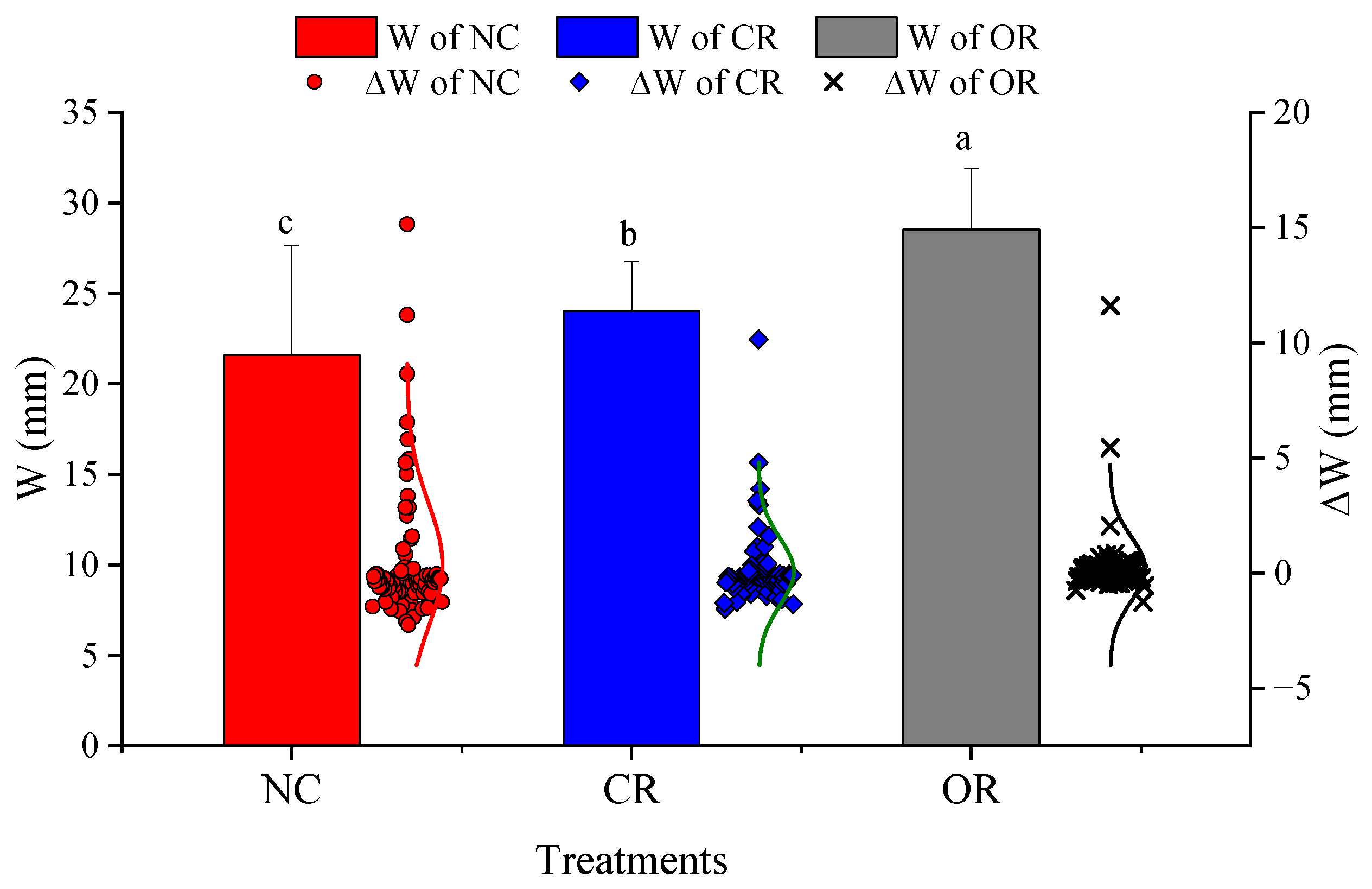

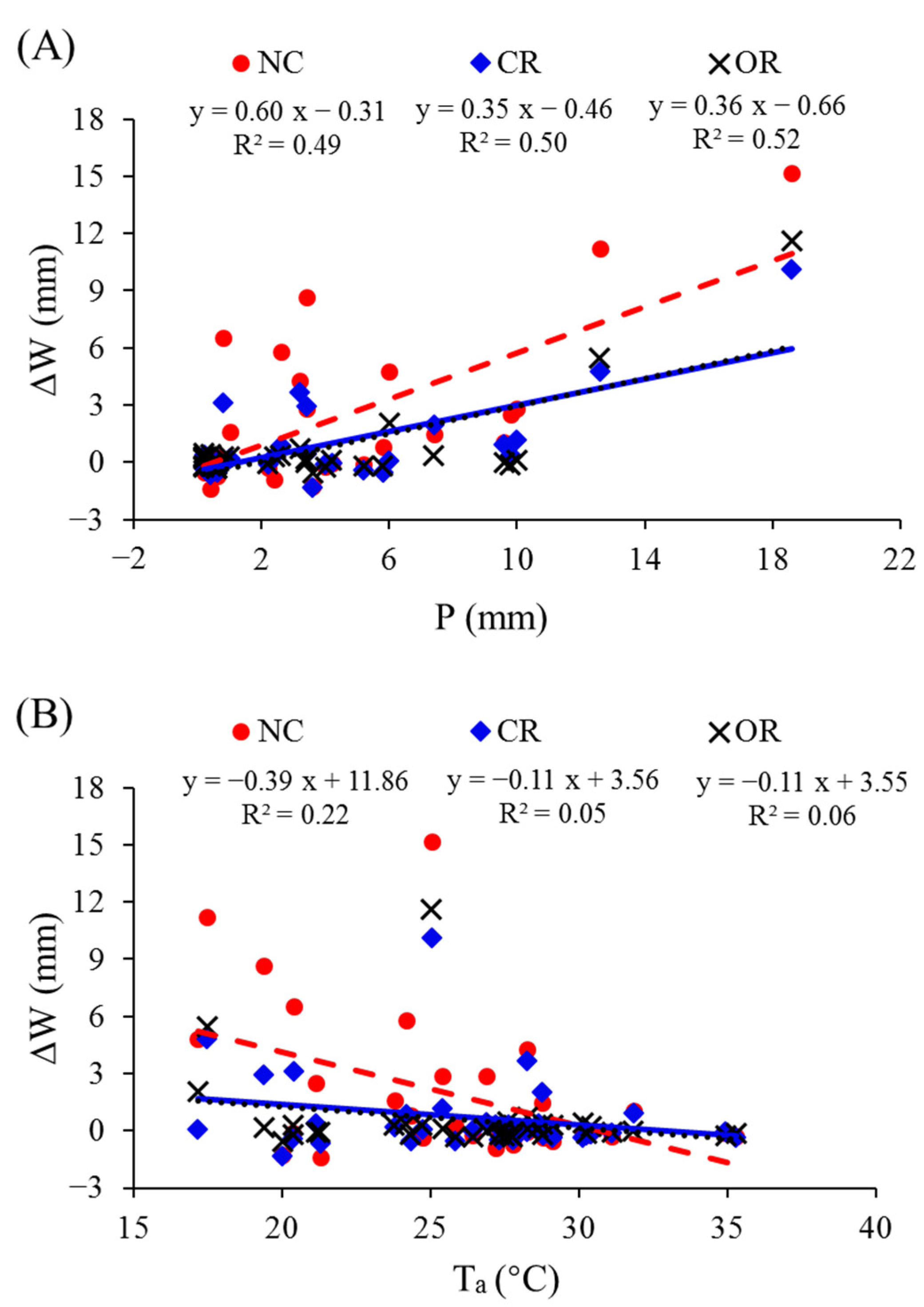
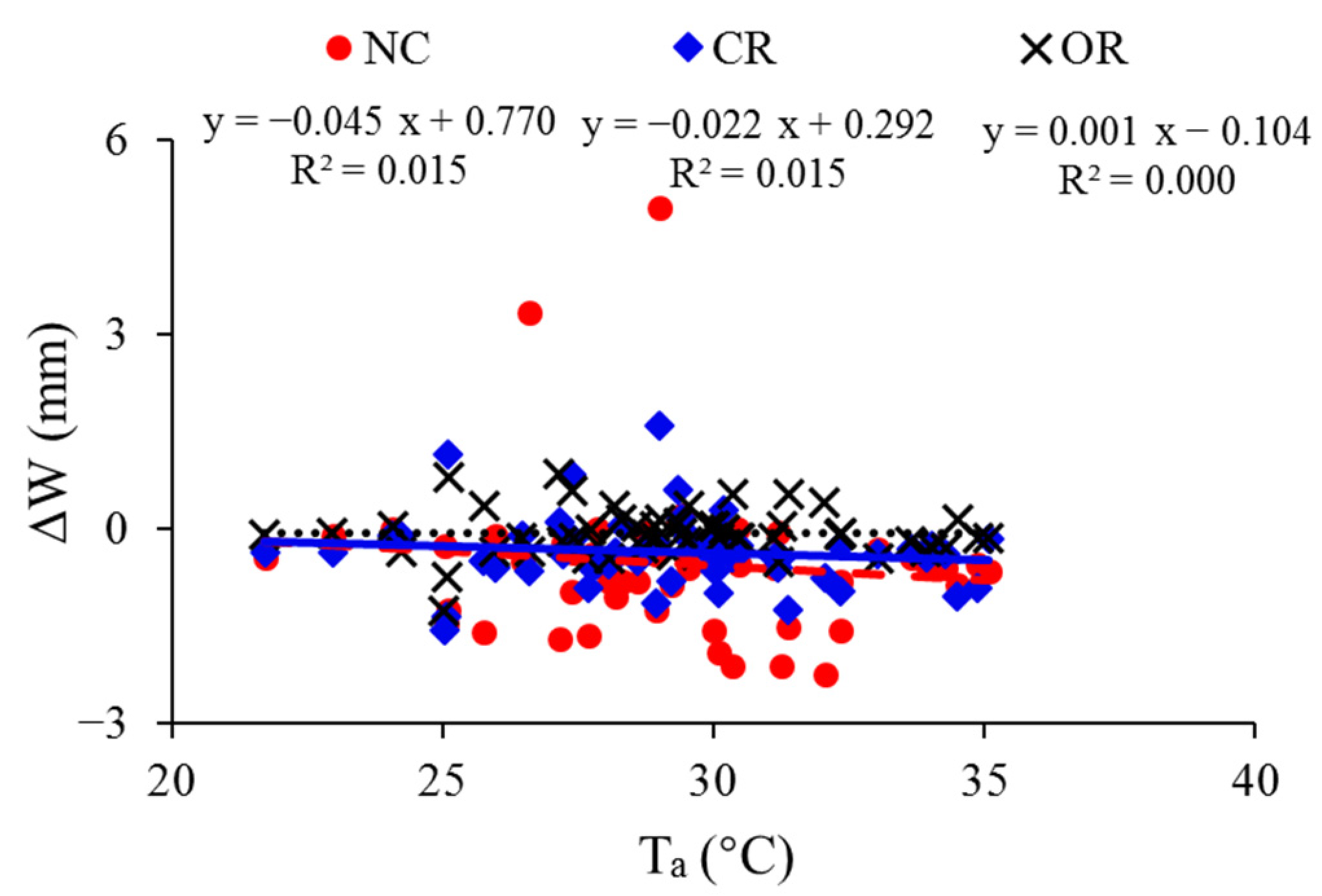
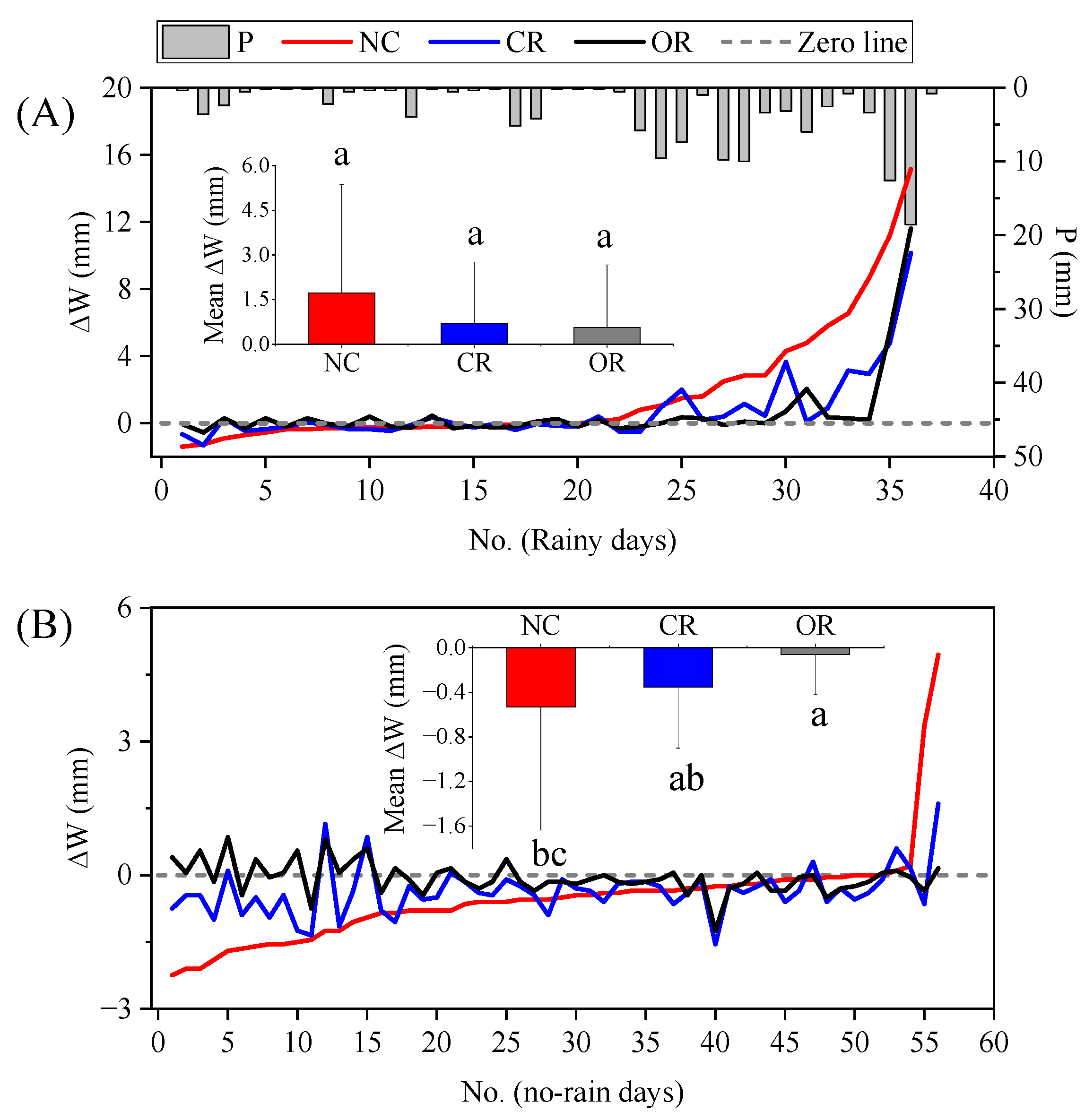
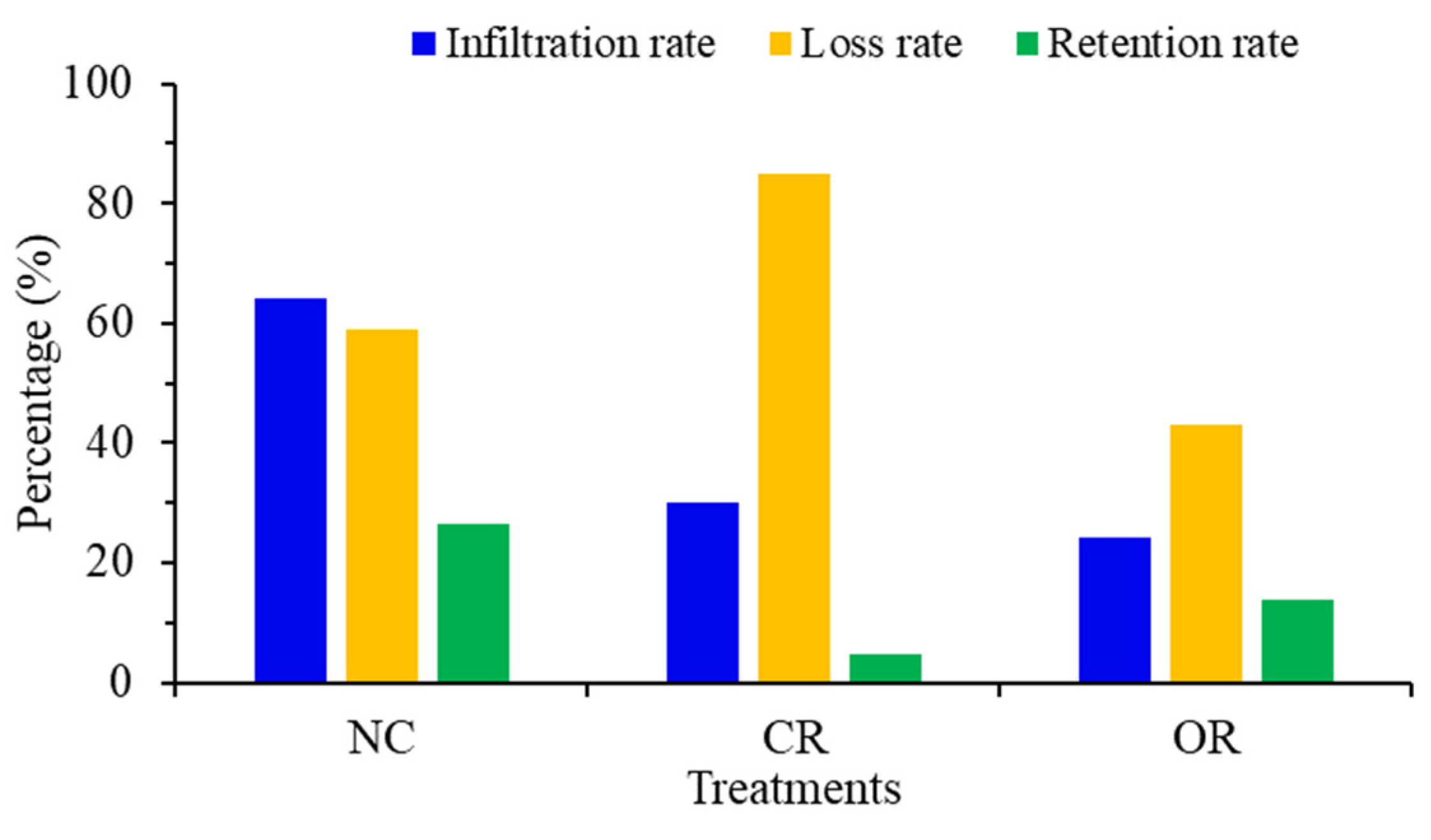
| Threshold | NC | CR | OR |
|---|---|---|---|
| P (mm) | 0.76 | 1.12 | 0.74 |
| Ta (°C) | 29.45 | 29.09 | 32.00 |
Disclaimer/Publisher’s Note: The statements, opinions and data contained in all publications are solely those of the individual author(s) and contributor(s) and not of MDPI and/or the editor(s). MDPI and/or the editor(s) disclaim responsibility for any injury to people or property resulting from any ideas, methods, instructions or products referred to in the content. |
© 2023 by the authors. Licensee MDPI, Basel, Switzerland. This article is an open access article distributed under the terms and conditions of the Creative Commons Attribution (CC BY) license (https://creativecommons.org/licenses/by/4.0/).
Share and Cite
Liu, J.; Chen, W.; Fang, W.; Zhang, B. Sub-Shrub Components Change the Soil Water Storage Response to Daily Precipitation and Air Temperature in the Loess Plateau. Water 2023, 15, 4157. https://doi.org/10.3390/w15234157
Liu J, Chen W, Fang W, Zhang B. Sub-Shrub Components Change the Soil Water Storage Response to Daily Precipitation and Air Temperature in the Loess Plateau. Water. 2023; 15(23):4157. https://doi.org/10.3390/w15234157
Chicago/Turabian StyleLiu, Jianbo, Weiliang Chen, Weiwei Fang, and Bing Zhang. 2023. "Sub-Shrub Components Change the Soil Water Storage Response to Daily Precipitation and Air Temperature in the Loess Plateau" Water 15, no. 23: 4157. https://doi.org/10.3390/w15234157
APA StyleLiu, J., Chen, W., Fang, W., & Zhang, B. (2023). Sub-Shrub Components Change the Soil Water Storage Response to Daily Precipitation and Air Temperature in the Loess Plateau. Water, 15(23), 4157. https://doi.org/10.3390/w15234157







